
Barrier-free benefits websites are key to benefits communication success
Living in the information age, we have round-the-clock access to just about every piece of information we could possibly want. When I think about how my 11-year-old son Jacob consumes information, I realize it’s constant and through every device available to him—his mobile phone or Surface, Chromebook, iPad, our family computer, Alexa, and Siri. Like most Centennials, he’s constantly looking up or researching information to satisfy his curiosity.
We do that as well. When there’s something we want to see, research, or do, we simply turn to our phone and Google it.
Finding benefits information should be that easy, too. That’s why a benefits website is one of the keys in our ebook series Unlocking Successful Benefits Communication: A 10-Key Framework Every Organization Needs to Get Results.
The Gateway to All Things Benefits
Think of your benefits website as your employees’ entryway to benefits, just like Google is for so many things on the web. As a hub—or connector—it should simplify the complex maze of benefits information, resources, and tools so that employees and their families can easily learn about their benefits and take action. The best sites should provide simple and easy access to the various providers that make up the benefits ecosystem.
For maximum impact, your benefits website should also be easy to access. That means it's available outside your company firewall, has an easy-to-remember URL (e.g., www.companybenefits.com), and not be password-protected. When employees need benefits information, they need it then and there; they shouldn’t be deterred by a firewall or a complicated login.
One last takeaway here: As one of the most important channels in your broader benefits communication strategy, your benefits website should be an extension of the entire employee experience and reflect your company’s brand.
Here’s what can happen when you apply these guiding principles to your benefits website.
A Site That Draws 14,000 Visitors Every Month!
One of our longtime clients, on Fortune's list of 100 Best Companies to Work For, invested in a global benefits website in 2007. This public site provides credential-free access to information for employees and their families. We initially created the benefits website for U.S. employees only, but over the past decade, we’ve continued to expand and enhance the site to reach employees and their families across 8 countries. The global site covers all the physical, emotional, and financial well-being programs offered and connects people to the dozens of vendors that support those benefits. Each country site provides information about the local benefits offerings and features culturally relevant content and images. At the same time, all the country sites reflect a consistent brand, platform, and framework.
We enhance and update the site regularly, driven by our client’s commitment to continuously improve the employee experience. Taking our cues from our client’s approach to product design, we make our decisions about site design and content organization on the basis of in-depth employee feedback gathered through one-on-one interviews and focus groups.
For instance, content features for the U.S. site include targeted information for employees and family members across 6 age bands as well as goal-based information to help users quickly identify benefits that can help them reach personal goals (e.g., “Fit into your skinny jeans,” “Enjoy your retirement,” and “Stop living paycheck to paycheck”).
Worldwide, employees love the site. The latest analytics show that it gets almost 14,000 unique visitors every month, well above the employee count of 9,000.
Science Tells Us Fewer Barriers Are Better
Here’s the science behind why you need to make your benefits websites as easily accessible as possible.
Digital attention spans have changed the way we process information. Our brains are trained to be advanced filters. We skim content more quickly and tune out the “noise.” Our patience for putting up with sub-optimal interactions is razor-thin, and our expectations of frictionless experiences have never been higher. Think about how much tolerance you have when you go to a website and it takes a long time for a page to load or you can’t find what you’re looking for. Or when you pull up a site on your phone and it’s difficult to navigate.
Negative experiences are barriers to benefits engagement. They’re the reason your benefits website needs to be fully responsive and thoughtfully designed. The site not only needs to look great, but it also needs to work well (i.e., load quickly on mobile phones).
Also keep in mind that you’re in constant competition for your employees’ time and attention. The reality is that most people would rather be catching up on Facebook or binge-watching Netflix instead of diving into HR and benefits content. By making your benefits website easy to use, you help remove barriers for engagement.
Cognitive fluency measures how easy it feels for us to understand something, and it affects our decision-making. If something is complicated or intimidating, we often give up, because we prefer to think about things that are easy. That’s why, if you make it hard for people to get to or understand benefits information, they will just go somewhere else—like Facebook or Instagram or their favorite news feed.
To solve for this, you can organize information around employee goals and priorities, not around HR and benefits silos. We do this for our clients’ websites. We provide layered content so that employees who have simple information needs can quickly and easily find the information they want, while others who want more details can get to them easily, too.
When you focus on the user experience and remove as many barriers as possible, you create a site that has satisfied repeat customers.
Learn more about the importance of benefits websites, and read other case studies like this in our ebook series, Unlocking Successful Benefits Communication: A 10-Key Framework Every Organization Needs to Get Results. Creating a standout benefits website is part of Book I: Foundation. Don’t miss the other books in the series, which show you how to market your benefits like a pro and how to get the right resources in place.

Jon Stuckey, VP Creative Technology and Innovation, provides strategic vision, guidance, and solutions for our largest clients.
